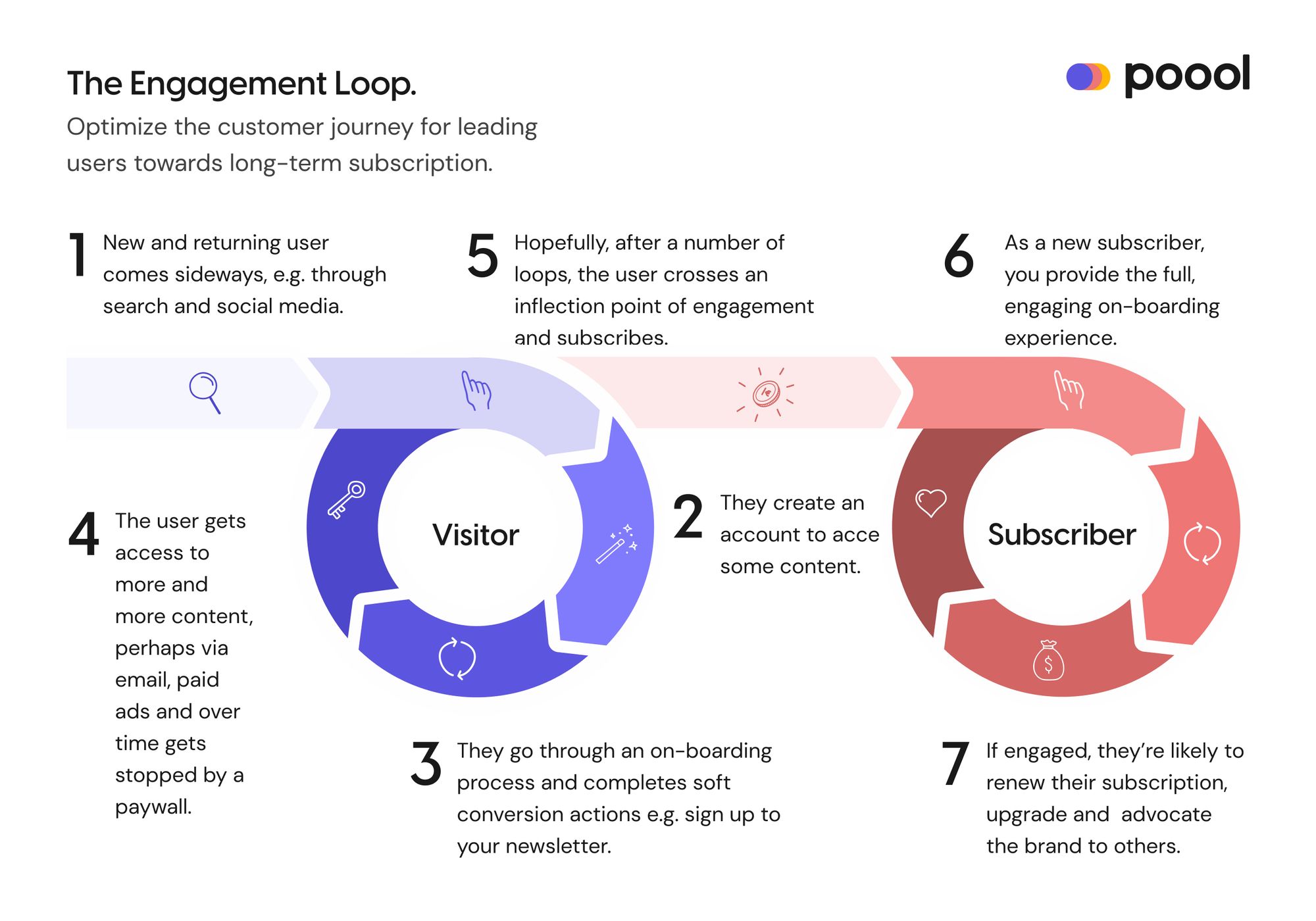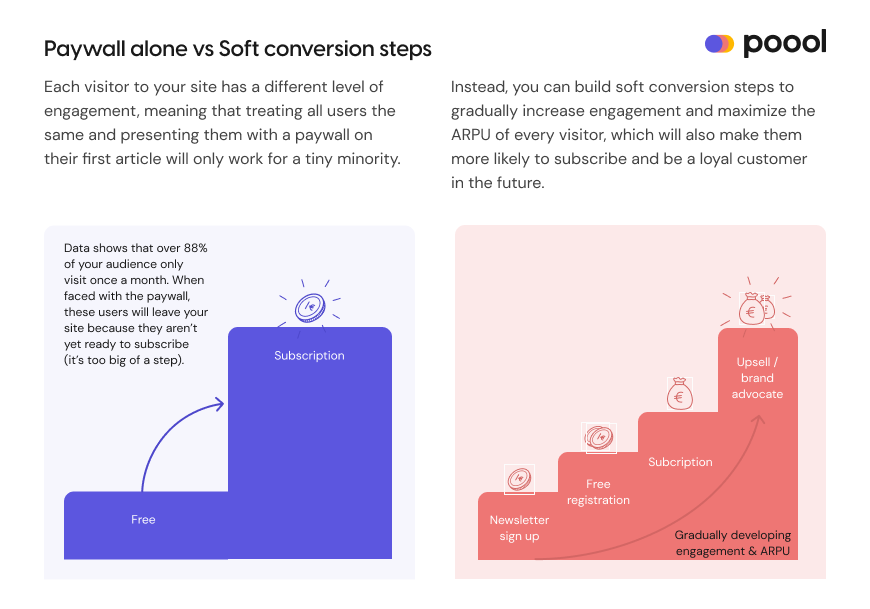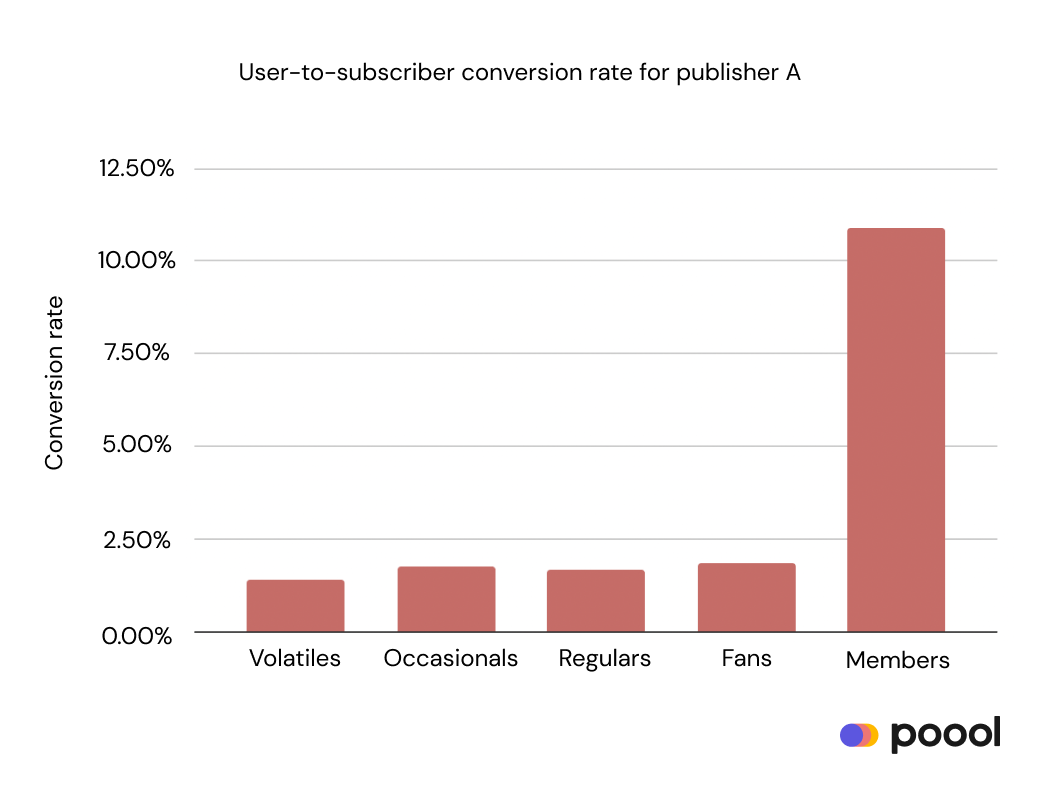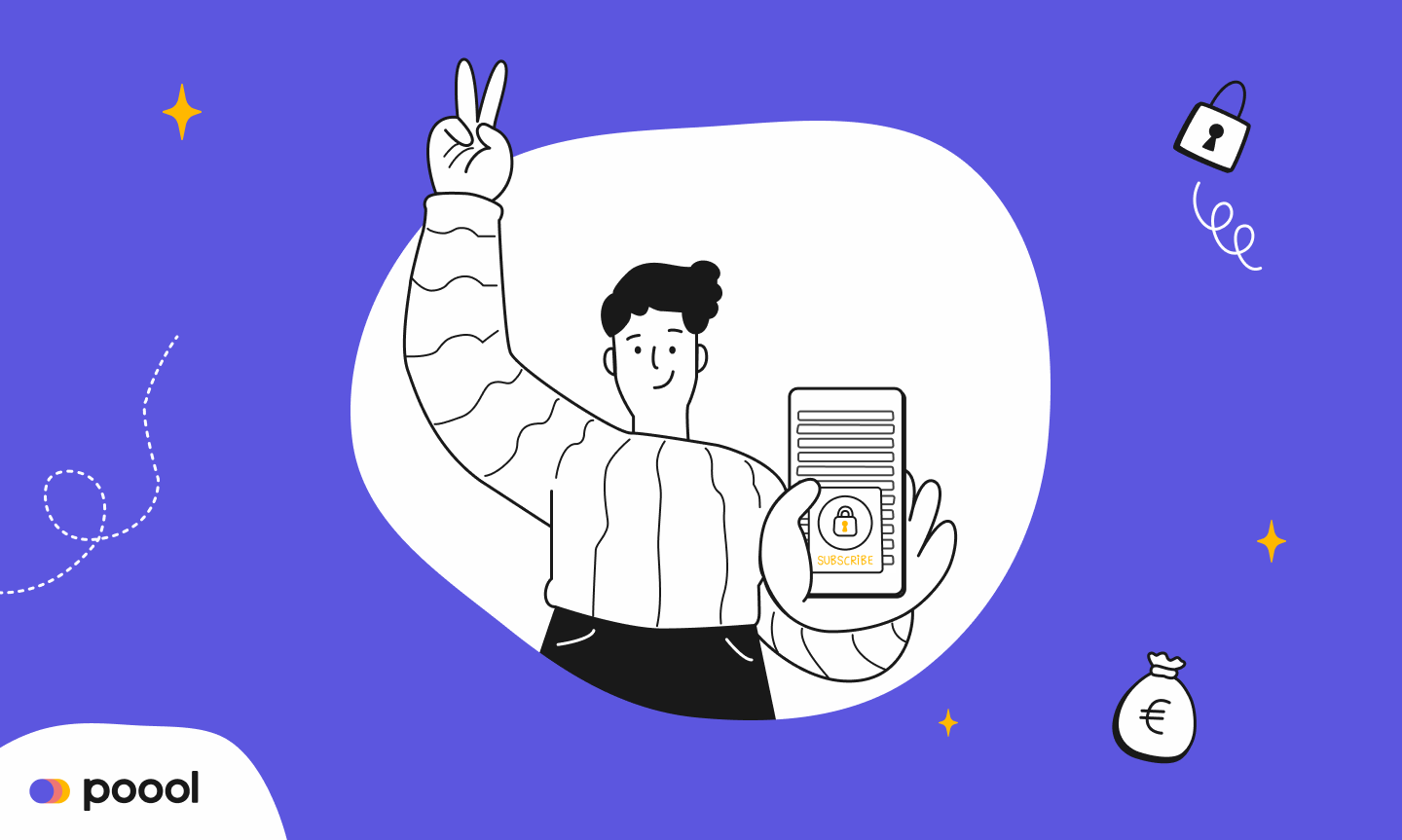It goes without saying that engaging your audience is vital to the success of your business. Our attention isn’t easy to get hold of, let alone maintain for a long period of time. But when a business succeeds in engaging users, it can have a hugely beneficial impact on conversion and retention rates, leading to significantly increased revenue.
So, how do you do this? How can a publisher engage their users, increasing the frequency and volume of visits to their site, in order to ultimately lead them to becoming a valuable, long term subscriber?
This white paper seeks to answer these questions, highlighting the importance of tracking and increasing engagement for content producers online. Then, to action this knowledge, we'll provide you with a wide variety of methods in which you can boost engagement, with concrete examples from successful digital publishers.
We’ll cover:
- Why engagement is so important
- How to track engagement
- How to increase engagement
- Soft conversions: registration wall, newsletter sign up
- Content: habit forming content, newsletters, puzzles
- Personalization: algorithms, UX functionalities, messaging, notifications
- Interaction: commenting, social media
1) Why engagement is so important
Vanity metrics, such as page views and bounce rates, have long been accepted as useful KPIs to track for online subscription businesses. However, these metrics actually provide little value to a publisher - high page views and good bounce rates don’t necessarily relate to propensity to subscribe and they unfortunately give little insight into what your audience actually find valuable.
Equally, conversion rates are important to track and help in the development of your paywall strategy, but this KPI doesn’t cover the entire funnel, particularly not pre or post subscription (find out more about our revised conversion rate framwork here).
There is, though, one metric to track that not only allows you to discover where your users see value on your site (pre and post subscription) and how you can continue to provide this, but also has a direct correlation with high conversion and retention rates, and so revenues.
Namely, engagement.
If we go back to the basics, a paywall and subscription strategy creates a value exchange on your website between you and your audience. If a user is interested in the value that you provide then they will pay in order to gain access to this value. You may even offer them more value in the future and persuade them to pay more (for a more premium offer or service, for example). However, if you don’t continue to provide them with value, they won’t likely want to partake in the value exchange.
Tracking engagement therefore provides you with insights into how valuable your audience considers your content to be and where they see this value on your site, allowing you to invest more in these areas. If you improve engagement and increase the ‘amount’ of value that you provide users, you’ll necessarily increase the ‘amount’ of value that they give back to you, namely revenue. Put simply, the more you put in, the more you get out.
In fact, it's engagement and this constant provision of value that moves a user through each step of the funnel on your site. Cleverly, INMA have proposed that we consider this as an engagement loop instead of a funnel, highlighting the importance of increasing engagement throughout the user journey, as both a visitor and a subscriber.

It’s therefore fair to say that engagement is an important KPI to track and not one to be left on the sideline in favor of pageviews or bounce rates.
2) How to track engagement
A variety of metrics have been put forward as the best for tracking engagement, with perhaps the most popular being MAU/DAU. These, however, aren't hugely actionable. So, we'd recommend employing the RFV engagement metric, a KPI that is both actionable and easily tracked throughout the user funnel.
Recency = the number of days since a user was last active on your website
Frequency = the number of days that a user has accessed your site in a given time period
Volume = the quantity of content accessed and interacted with
We recommend measuring this metric globally (all users) as well as on your VORFMS - Volatiles, Occasionals, Regulars, Fans, Members and Subscribers - equally employing it to spot less engaged subscribers and take preventative measures to reduce churn.
Importantly, this metric will provide you with insights into where users are the most engaged, allowing you to produce more of this type of content.
To demonstrate, this demand and supply analysis table, from INMA 2018, shows how an understanding of where users are the most engaged allows you to re-evaluate the production of content in order to continue to attract and retain subscribers.
For this media, work should be done to reduce content in the culture area whilst producing more content on transport, healthcare, real estate and crime.
In addition to the RFV engagement metric, Customer Lifetime Value is an essential KPI to track and seek to increase.
A high CLV implies that your subscribers are engaged and continue to see value in your content. Therefore, by increasing engagement, you increase CLV and ultimately revenues.
Customer Lifetime Value refers to the total net revenue that a subscriber will bring to your business throughout their entire lifetime as a paying customer. The longer a user continues to subscribe to your content, the higher their lifetime value becomes. You should therefore aim to retain subscribers through continued engagement as this directly correlates to increased revenue.
You can calculate CLV by multiplying the average recurring revenue by the total length of subscription.
For other KPIs that you should be tracking in your paywall and subscription strategy, take a look at our ultimate guide on the Poool blog!

3) How to improve these KPIs
It’s one thing to understand that engagement is essential, but it’s a whole other ball game to improve it. Here, we’ll work through 4 key areas that allow for building engagement levels amongst your users:
- Soft conversions
- Content
- Personalization
- Interaction
- Soft conversions:
Gone are the days of hard paywalls that block users on their first visit to your site (except if you’re The Financial Times that is). Instead, a visitor can be nurtured, gradually being increasingly engaged and converted into a lead prior to a subscriber. This is what soft conversion refers to - all of the smaller steps (micro conversions) that a user takes, bringing them closer to subscription (the macro conversion).

Encourage newsletter sign-up
Newsletters are hugely valuable for increasing engagement and encouraging your users to visit your site more frequently, becoming more loyal to your brand which you can then monetize later through subscription. In particular, emails received on a regular basis (e.g. every morning) can form habits within your users’ lives (we’ll cover this in more detail later) and can be personalized to inform a user when you release content that they are likely to find valuable.
Encouraging users to sign up to your newsletter can be achieved in a variety of ways. For example, you could block content with a newsletter wall that requires them to register on your email list in order to view more content for free. This is what Le Journal du Dimanche have on their site, significantly increasing newsletter registrants who are highly more likely to subscribe than anonymous readers.

Alternatively, you can make sign up easy by promoting it on other parts of your website. For instance, the Spanish publisher El Diario includes a newsletter panel by the side of articles where users can simply click on a topic and enter their email address in order to receive newsletters adapted to their interests.
You can also promote newsletters to new subscribers in order to increase engagement and consequently retention rates. A Spiegel study, analyzing two online news outlets, found that subscribers who received emails promoting relevant, quality news content had significantly higher retention rates than those who didn’t. This highlighting how newsletters are a valuable asset to publishers and shouldn't be forgotten.
Perhaps the best time to promote newsletter sign up to subscribers is during the onboarding process, right after they confirm payment. The New York Times makes the most of this opportunity and enables new subscribers to register to multiple newsletters simultaneously, highlighting that they’re part of the value that they receive as a paying subscriber.
Employ a registration wall
An alternative soft conversion step is to block your content with a registration wall, requiring that a user creates a free account in order to continue. The benefits of this approach are plentiful as you can not only collect valuable first party data from the user but you can build a closer relationship with them through a more personalized experience. In turn, this customized experience means the user is more likely to be engaged in your content (that’s adapted to their interests) and potentially become a subscriber in the future. In fact, registered users are up to 200% more likely to convert to a subscriber than anonymous readers.

Data from one of Poool's clients shows how conversion rates are significantly higher for registered members compared to anonymous visitors.
Harvard Business Review, for example, employs a metered registration wall where users are free to read 2 articles before being blocked and asked to create a free account to access more content (the banner at the bottom of the screen informs us of how many articles we have left).
This extra soft conversion step prior to subscription allows the publisher to turn unknown audiences into more engaged leads through email and data collection as well as a personalized experience thanks to an account space on the HBR site. Read more about their registration wall journey here.
- Content:
Of course, your content provides the central means by which you’ll engage your audience. However, not all content is created equal and some are more valuable to you than others thanks to their ability to stimulate engagement.
The first step, therefore, is to use data to pinpoint exactly what content engages your audience the most and ensure to invest in those areas more than others (remember the supply/demand analysis presented above).
Form habits
Before digital publishing was a thing, reading printed newspapers and magazines was a daily ritual for many consumers around the world. However, since then, content producers have lost their ‘slot’ in people’s habits and moved from publishing at a set time (i.e. people would read that day’s morning paper) to producing a fairly constant stream of content. Publishers should therefore seek to go back to being an essential part of their reader’s day, forming a habit that creates repeated and ritualized engagement.
To help understand how a habit can be formed, we can consider this ‘hook canvas’ from Twipe.
The hook canvas suggests that it’s a craving/desire that powers the habit loop and that you, as a publisher, need to provide something that triggers that craving. The trigger could be internal, through the user’s own desires (leveraging readers’ existing routines and desires such as a morning update or content to consume on their commute to work), or external, through the publisher’s action (like employing push notifications or sending newsletters to users). The action that follows is perhaps clicking a link on your newsletter or opening up the morning update.
The reward and investment are when the content satisfies the user’s cravings but, equally, makes them want to come back for more on a regular basis. Succeed in creating this loop and you’ll gradually form a habit in your users’ lives, ensuring that they consume your content on a regular basis.
But what kind of content/features are useful for habit forming?
- Establish a content ‘theme’ to be released at a certain time of day (e.g. morning newsletter)
- Publish content for a specific situation that’s already a part of your user’s habit (e.g. having a coffee in the morning or commuting to work)
- Produce content series where users will wait for the next ‘episode’ to be released (like Les Jours)
- Send push notifications or email newsletters to repeatedly remind users of content (read on for more on this)
- Reward engagement on a regular basis (Duolingo, for example, encourages users to use their app on a daily basis, celebrating their ‘streak’ of how many days in a row they’ve consumed content for)
- Regularly publish interactive content to engage whilst entertaining, such as puzzles and crosswords that fulfil a craving for users when finished but equally encourage them to come back for more in the future (In early 2019, the New York Times’ crossword puzzle app passed the 500,000-subscriber mark, according to the Local News Initiative)
Twipe’s infographic is also useful here, providing 6 of the key reader cravings found from their study on habit forming for publishers.
Importantly, for new subscribers and registered users, the onboarding scenario that you lead them through is your first, and perhaps most valuable, opportunity to create habits and engage them from day one. You could promote your newsletters, making it easy for them to register, encourage a user to download your app or allow them to set up notifications for new content releases on topics that interest them.
The Economist, for example, promotes their app and allows for easy sign-up to multiple newsletters, boosting engagement from the moment a user registers/subscribes.
- Personalization:
The ability to personalize content and tailor experiences to a user is one of the greatest ways to boost engagement. If a user gets presented with content that matches their interests (content that you know will engage them) then their frequency and volume of visits is likely to increase significantly.
There’s a variety of ways that you can achieve this personalization, but the initial step is to collect and analyze user data (through requiring registration or subscription) in order to understand your audience and segment them into increasingly smaller groups to target their experience.
Employ AI algorithms
In the past, personalization was an added bonus that set a business apart from competitors. Today, however, thanks to machine learning allowing for every aspect to be tailored to a user (from content to advertising and messaging) it’s more of an expectation from online users.
‘Machine learning personalization is based on various factors. Analytics, filters, and algorithms all come together to understand users. Their behavior, preferences, methods, and more are compiled into data points. An algorithm takes those data points, or other kinds of input, and uses them to create an output.’ - TMS
Netflix and other video streaming platforms are ahead of the game in this area, presenting entirely personalized home pages for every user (no two individuals will have the same films and series displayed on their Netflix home page, for example). These companies utilize algorithms to constantly update content based on a user’s viewing habits, placing the most fitting content at the top and providing adapted recommendations. Netflix even has a ‘% match’ to inform a subscriber of how likely they are to like that content.
By promoting relevant and personalized content to each individual user, they are highly more likely to engage - for any content they consume, they’ll be recommended something similar, encouraging continued engagement (just like on youtube where you watch a video and are recommended another similar video, that then leads to another and another…).
We can also think of more innovative personalization using algorithms. For example, Spotify Wrapped, which is sent to listeners at the end of each year, summarizes and celebrates a user’s consumption over the past year. It’s become something that people look forward to and share on social media to show others how much audio they listened to and what content defined their year. It therefore provides a way of encouraging increased listening and engagement whilst simultaneously creating a way to promote Spotify - receiving your ‘Wrapped’ at the end of december makes you part of the subscriber community, necessarily excluding anyone who isn’t using the audio streaming platform.
Make the most of UX functionalities
An alternative approach is to put UX functionalities in place that allow a user to personalize their account and experience themselves.
For example, you could allow users to save content to access another time, follow topics/authors and receive notifications for certain content releases or announcements.
The Globe and Mail, a Canadian publisher, has mastered this personalization technique by adding the below information at the end of every article. It allows a user to follow topics related to the content that they’ve just consumed as well as the author who wrote that article. Cleverly, they don’t allow anonymous users to use this functionality - you have to create a free account first, meaning that they not only encourage engagement through this ‘building of your feed’ but also collect data about the user and can further improve their experience to nurture them towards subscription.
The South China Morning Post also encourages users to follow a topic but this is achieved via a popup, meaning they can promote a specific topic of their choosing (for example current affairs, such as content about Covid-19).
Personalize messaging
This involves directly addressing your audience with personalized messaging. It could be simply adding in their name, or altering wording based on content they’ve consumed or preferences.
Medium, for instance, adapts their paywall based on the user and writer of the article, making us feel directly addressed, helping to build the foundations of a lasting relationship and boosting the CTR on the paywall, all ultimately increasing conversion rates, retention and engagement. Personalizing by simply adding a user's name may seem like a small detail, but these add up to big gains for your subscription strategy.
However, there is an important middle ground to find between not personalizing and going too far. If you over personalize, users may feel that their data privacy isn’t being respected and that you know too much about them as an individual. Consequently, we’d recommend carrying out tests to discover where this sweet spot is and ensure you’re making the most of data that you have from your audience without stepping over the line.
Push notifications to remind and notify
Aside from posting on your website, how will users know when you’ve released new content? Subscribers may be able to ‘follow’ topics as discussed above but setting up push notifications can take this a step further. In particular, they can be hugely valuable on your app for providing real-time messaging and notifications to users on their phones anywhere, at any time.
‘Direct messaging channels like email and push notifications help publishers overcome their dependence on third-party referral platforms like Facebook and Google and take back control of their audience engagement to build stronger, trusted relationships with their subscribers.’ - Powerinbox
According to Powerinbox, they’ve seen a 22% increase in revenue amongst publishers who implemented automated and personalized push notifications. Clearly they're a hugely valuable tool for driving engagement, putting publishers in control and creating personalized reminders/notifications for the user based on their interests.
The BBC News app makes the most of push notifications to inform users of new stories around real-time events. These can be disabled (an important thing to allow your audience to do) or personalized to only show content that matches the user’s interests.

- Interaction
Captivating your user’s attention is no easy task and doing this on a repeated or extended basis is even more difficult. However, by switching up your content, approaching engagement from different angles and captivating your audience in ways other than regular content, you can significantly increase engagement time and frequency. In particular, creating ways for your users to interact with you, your content and each other is a hugely valuable way to do this.
Interaction allows you to vary the forms of engagement, moving from just reading, watching or listening to sharing, liking, commenting, etc, ultimately meaning you engage users for longer. What’s more, interaction can happen both onsite, through comment sections, and offsite, such as with notifications and social media that both provide constant reminders to users that you exist and encourages engagement without them even needing to take the step of going to your website.
Create space for forums, debates and commenting
For many publishers, comment and debate sections are outdated and only lead to trolls who ruin the conversation for the rest of your audience. However, the potential engagement, relationship-building and monetary value that these sections can provide arguably outweighs the risks involved, especially if you can employ moderators or machine learning technology to remove unwanted comments. Even if you only have a small minority of users who join the conversations, the profits will be well worth maintaining this feature on your website.
Simon Owens sums it up very nicely:
‘Let’s be clear: even the publishers with the best comment moderation still only see a small percentage of their readers convert into on-site commenters. But let’s say only 5 percent of your readers choose to register and comment; those readers will punch far above their weight in terms of driving traffic and revenue to your site. Those are your chief evangelists, your repeat customers, your paying subscribers.
To understand how a small percentage of a publisher’s most loyal users can drive revenue growth, consider The New York Times. Currently, its digital subscribers only account for 3.6 percent of the newspaper’s monthly online audience, and yet that 3.6 percent drove over $400 million in subscription revenue in 2018. When you’re dealing with the scale of the internet, catering to your most engaged readers is worth the investment.’
Le Drenche goes one step further and publishes ‘debate’ content where two experts layout their side of an argument. Cleverly, they encourage users to vote on their opinion at the start of the article and again at the end to see if their point of view has changed.
Whilst the South China Morning Post allows registered users to join ‘conversations’ in a sidebar on content.
If you’re looking to encourage commenting and discussions on your content, an American Press Institute report found that certain topics and content formats lead to more conversations than others:
‘More comments appear on articles with several key attributes, according to research by University of Zurich doctoral student Patrick Weber. News about events that have a clear beginning and end, for example, yields more comments than news about ongoing situations. This result suggests that an article describing a jobs bill being passed would receive more comments than an article about ongoing debate about the same bill.’
Have a social media presence
It’s no secret that having an account and presence on social media is an essential part of your marketing and engagement strategy. By posting about new content, asking your audience questions, encouraging likes/shares/click throughs and inciting discussions outside of your website, you will simultaneously boost engagement onsite too.
However, it’s important to adapt your strategy based on the social media platform that you’re posting on, ensuring that you’re maximizing your chances of engaging that specific audience.
Let’s take the example of The Independent.
On LinkedIn, they solely post articles relating to work, professionalism, employment, etc - this matches the purpose of LinkedIn as well as the reason why a user would choose to scroll through their feed on this platform.
Whilst on Instagram, they have a central page where a variety of key news stories are posted as well as a few other, more focussed accounts covering specific topics (such as Independent Climate). All posts are very visual (a mix of photos and videos) and often include a short description, headline or question to catch the attention of scrolling users.
In addition to linking the specific content in the caption of each post, they also make use of the stories feature on Instagram to share other news stories. If the image catches a user’s eye, they can simply swipe up and they’ll be redirected to the article on The Independent’s website.
To conclude, there are a great number of ways that you can increase your audience’s engagement with your content and website. Perhaps, though, there are two key takeaways to remember:
Firstly, aim to create habits in your audience’s lives. One of the easiest ways to do this is by creating content specifically for a habit that your audience already have (e.g. commuting). Half the work is done (the habit is already there), all that’s left to do is to fit your content into this routine.
Secondly, in order to get hold of and maintain your user’s attention, it’s important to vary how you engage them. Providing a variety of engagement points, from content and UX functionalities to social media, newsletters and notifications, you encourage your users to engage in different ways, reducing the likelihood of them losing attention whilst increasing the presence that you have in their life.
Interested in increasing engagement with a newsletter, registration and/or paywall? Or how about some adapted advice from Poool's expert consultants? Book a meeting and free demo with our team now!
You may also be interested in:




